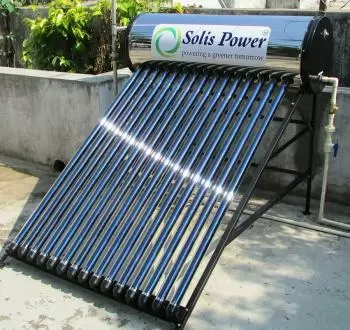
Thermosyphon solar systems are solar energy equipment that works with the natural circulation of the working fluid without needing any mechanical pump. This circulation is based on convection currents that form in fluids at different temperatures.
What is the thermosyphon principle?
The thermosiphon is the physical phenomenon by which a fluid circulation is established in a closed circuit due to the density difference between the fluids at different temperatures.
The thermosiphon principle is used in some solar thermal energy systems when the structure of the pipes allows it. To do this, it is necessary that the path of the heat transfer fluid is at various levels and is not too long. Therefore, the movement of the heat transfer fluid between the solar panels and the hot water tank is carried out solely by convection.
Uses of solar thermosyphon systems
A thermosyphon solar panel is used to heat a home's heating water or obtain domestic hot water through renewable energies.
If we heat a tank of water from the bottom, it loses density when the bottom water of the solar tank is heated. Consequently, the heated water rises and the cooler water down to the bottom of the tank.
It is the operating principle of thermosyphon solar water heaters, in which it will be essential that:
-
The solar panel is always located at a lower level than the tank.
-
The primary circuit of the solar thermal installation is as short as possible and with a continuous slope that facilitates natural circulation.
Thermosyphon thermal solar installation diagram
The cycle of a thermosyphon system begins when solar radiation strikes the solar panel, with values greater than 200 watts/m2. As a result, the barrier fluid located in the solar collector increases its temperature.
Due to the increase in temperature, the flux density varies slightly. This variation is enough for the fluid to circulate through the primary circuit to the tank, ranging from 100 to 300 liters. The cold liquid is denser and tends to go down; likewise, the hot fluid tends to go up.
Once the fluid is in the tank, heat exchange is carried out using convection.
What is the temperature difference of a thermosyphon?
The temperature difference in the primary circuit of a thermosiphon solar panel is usually 5 to 15 degrees Celsius. However, it depends mainly on the insolation level.
As it heats up, the water in the tank is stratified by temperature. The upper part is occupied by hot water, and the colder water remains in, the lower part.
In vertical tanks, this temperature differential from the top to the bottom of the solar tank can reach 15ºC. On the other hand, this differential drops to only 4-5 degrees Celsius in horizontal tanks.
Types of thermosyphon: horizontal and vertical
Since the operation of the thermosyphon system depends on the stratification of the water in the storage tank, vertical tanks are more effective. It is also preferable to have the auxiliary heater as high up in the storage tank as possible, to heat only the top of the tank with extra power when needed. It is essential for three reasons:
-
Improves layering.
-
Tank heat losses increase linearly with storage temperature.
-
The solar collector operates more efficiently at a lower collector inlet temperature.
However, horizontal tanks are often used to reduce the unit's overall height. The flat tank's performance depends on the fluid's conduction from the tank to the solar panel.
The performance of these systems can be improved by using separate solar and auxiliary tanks or by separating the extra and preheat zones with an insulated baffle. A disadvantage of two tank or segmented tank systems is that the inlet cannot heat the auxiliary zone until there is a demand.
Essential components of a solar thermosyphon
Thermosiphon solar thermal systems have a straightforward configuration with few elements. The most critical parts are the solar collector and the accumulator.
Solar panels
In thermosiphon systems, the circulation of the water that circulates through the solar panels is not forced. As it is not a forced circulation, the load loss is minimal. Thus, it means that the tubes that form the grill of the solar panel have a circular section and the maximum possible diameter.
Regarding the number of connected solar collectors, connecting more than 10 m2 of collectors is not recommended. The reason is to avoid loss of charge in the collection circuit and avoid a considerable reduction in the performance of the solar installation.
Solar accumulator tank
The accumulator used in equipment with indirect circuit thermosiphon operation is usually a double envelope. Double shell accumulators have a larger thermodynamic exchange surface with the minimum pressure drop in the circuit.
The arrangement of the storage tank will facilitate natural circulation. In this case, the best configuration would be to use vertical tanks to take advantage of the temperature stratification. However, the conditions of aesthetic integration mean that most of the units incorporate horizontal tanks.
Connections and mechanical seals
Another quality to consider is that the water intakes of the primary circuit components have a diameter similar to that of the connecting pipe. It helps to avoid pressure losses that flow reductions represent.
It is also essential that the cold water inlet is located in the lower part of the tank. This action prevents cooling the hot water area when new water enters.